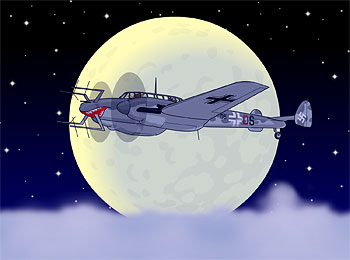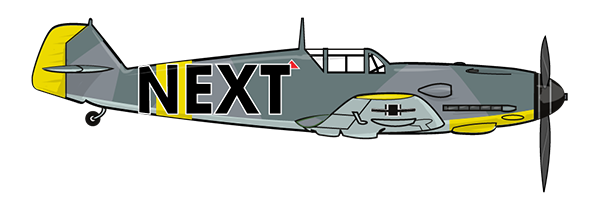
Despite the Stuka's reputation, it was another airplane that really made the Luftwaffe a formidable opponent during the early years of the war...the Messerschmitt 109. The Me109 outclassed almost every other fighter plane in Europe in the first years of the war, partly owing to its superior performance and even more so because of the experience and leadership of its pilots, who had already been blooded in combat in the skies over Spain during the Spanish Civil War. Willy Messerschmitt followed a very simple design philosophy for the 109, one that has since been imitated by backyard muscle car enthusiasts everywhere in America: he built the smallest airframe he could and then bolted it to the most awesome, fire-breathing engine he could find. The concept worked well, but like your average Chevette with a 350hp big block shoe-horned into it, it suffered a few compromises . There was a very limited amount of space in the no-frills airframe for more equipment, so upgrades to its armament or other improvements later in the war arrived in the form of unsightly and aerodynamically inconvenient bumps and bulges. By war's end, the once-speedy 109 was lagging behind its contemporaries and was so ugly even bugs flew around it. But in its early years, the Me109 was the most dangerous fighter on the continent.

The 109 was not the real darling of the Luftwaffe at this time, however. That honor belonged to the Me110, a twin-engined fighter that, while versatile, was largely overrated and eventually proved to be an embarrassment to the Luftwaffe during the Battle of Britain, when the "heavy fighter" pilots found themselves in the ironic position of requiring fighter escort from the more nimble 109's. It's hard to keep a good weapon contract down, though, so the Me110 continued to soldier on right up until the end of the war, spending the autumn years of its combat career as a night fighter, which is the fighter plane's job equivalent of a Walmart greeter. Failed fighter plane designs are rarely described as such by the military, which spends huge amounts of taxpayer money on them and can ill afford to admit they are dogs. Instead, the planes have their production orders whittled down a bit, and the surviving examples are relegated to less glamorous roles, like pilot training or target towing, or they are sold off to smaller countries who lack the budgets for the really good planes.
Me110 notwithstanding, the Luftwaffe pulverized the Polish Air Force, catching a large portion of it still on the ground during the early hours of the attack, and hacking the rest of it from the air with seeming impunity. The Coup De Grace was delivered by the Luftwaffe as well, which bombed the city of Warsaw mercilessly until the Polish government decided that it might be safer to govern from somewhere else...like Romania, or England. Anywhere with a roof.
The Luftwaffe had already established a reputation for "terror bombing" at Guernica during the Spanish Civil War, where they dropped over 100,000 pounds of bombs on that city, killing over 1500 civilians and destroying almost everything in the town except for its sole military target, a lone bridge that remained untouched. This event was immortalized by the famous Picasso painting of the same name and shocked the world at the time. (The bombing, not the painting...although the painting is pretty weird.) In fact, controversial civilian targets were largely avoided by both sides for a good while following Warsaw, until the airplane again shaped the course of World War II...this time by accident.







